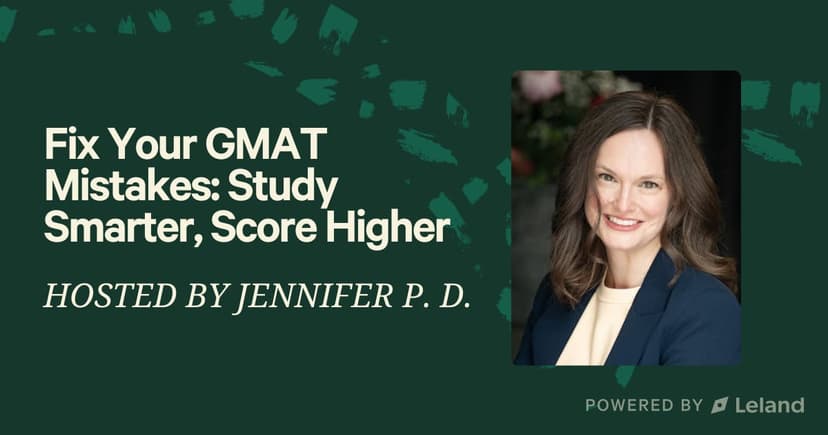
Join a free event
Learn from top coaches and industry experts in live, interactive sessions you can join for free.
Table of Contents
GMAT rate problems can trip up even high scorers, not because they’re impossible, but because they disguise themselves. Is it a question about distance, work, or average speed? Are you supposed to calculate a constant rate, or work backwards from the total distance and time?
This guide will show you how to identify the type of problem you’re facing confidently, apply the right formula, avoid common traps, and solve quickly under pressure. We’ll also walk through expert-level strategies, GMAT-style practice problems, and explain the “why” behind each step so you can internalize the logic, not just memorize equations.
Read: 3 Things You Need to Know About the New GMAT Focus Edition
Types of GMAT Rate Problems (And How to Identify Them)
There are three core types of rate problems on the GMAT:
| Type | What It Tests | Real-World Example | Core Formula(s) | Common Traps | When to Use This Approach | GMAT Keywords to Watch For |
|---|---|---|---|---|---|---|
| 1. Distance / Speed / Time | Your ability to apply basic distance relationships and manipulate units | “A car travels from Point A to Point B at 60 mph. How long does it take?” | Distance = Rate × Time Rearranged as: Time = Distance / Rate Rate = Distance / Time | Forgetting to convert time units (e.g., minutes to hours), mismatched units, and plugging into the wrong version of the formula | When you’re dealing with physical movement (cars, planes, runners, trains, etc.) and have two knowns out of the three: Distance, Speed, or Time | trip, miles, car A, car B, average speed, entire trip, speed, miles per hour, hours, total distance, distance equation, car travels, 60 miles |
| 2. Work / Job Problems | Whether you understand how combined rates work when multiple people/machines collaborate | “Two machines together can complete a job in 5 hours. Machine A alone takes 8 hours. How long does Machine B take?” | Work = Rate × Time Combined Rate = R₁ + R₂ Time = Total Work / Combined Rate Use a smart “total work” like 60 units to avoid fractions | Adding times instead of rates, treating rates as inverses incorrectly, mislabeling machines or people | When two (or more) entities are working toward completing the same job or task, especially when they’re working together or alternating | total work, individual rates, combined production, one machine, two machines, machines working, job, practice problems, total number, formula, individual production, two people, complete, total work |
| 3. Average Speed / Rate | Testing your understanding of what average speed really means over different legs of a journey | “A car goes to a point at 30 mph and returns at 60 mph. What is the average speed for the trip?” | Average Speed = Total Distance / Total Time | Taking the average of the two speeds (e.g., (30 + 60)/2) when the distances are the same but the times are not | When there are multiple legs of a journey, usually with different speeds, and you’re asked for the overall average rate | round trip, average speed, total distance, total time, two speeds, return trip, goes and returns, different speeds, mph, overall rate |
GMAT twist: Many questions mix these types, especially in Data Sufficiency, by giving one equation, leaving out a value, and asking if there’s enough information to solve.
Read: GMAT Sections Guide: What’s Tested and How to Prepare
Go-To GMAT Rate Formulas (And Exactly When to Use Each One)
On the GMAT, rate problems aren’t just about plugging into formulas; they’re about choosing the right approach quickly based on context. Here’s how expert test-takers think about the core formulas and when to use each.
1. Distance = Rate × Time
This is the foundation for any problem involving movement: cars, runners, trains, and planes.
You’ll often rearrange it as:
- Time = Distance ÷ Rate
- Rate = Distance ÷ Time
Use it when:
- You're given two of the three values (distance, rate, or time)
- You're dealing with miles per hour, hours, or miles
- Units match, and you’re calculating a trip leg
Expert tip: Always double-check your units. If rate is in miles per hour and time is in minutes, convert before multiplying. Unit mismatches are one of the easiest mistakes to make under pressure.
2. Work = Rate × Time
This is the go-to formula for job or task-based problems, where someone (or something) is working to complete a task.
When two workers (or machines) are involved, use:
- Combined Rate = R₁ + R₂
- Time = Total Work ÷ Combined Rate
Use it when:
- You’re dealing with people, machines, or systems working together or in sequence
- The question is about completing a job, not going a distance
- You’re given one rate, one time, and are solving for total work (or vice versa)
Expert tip: Pick a smart value for Total Work, like 60 units, when no total is given. It makes fractional rates (like ⅓ or ⅕ of a job per hour) easier to manage and avoids unnecessary algebra.
Common mistake: Don’t add times. You add respective rates when workers are collaborating.
3. Average Speed = Total Distance ÷ Total Time
This formula shows up when a trip involves two legs at different speeds, usually “there and back.”
Use it when:
- The object is making a round trip
- Each leg has a different speed (and often a different time)
- You’re asked for the car’s average speed or the average rate of travel
Expert tip: Don’t fall for the trap of averaging the speeds. If a car goes 30 mph one way and 60 mph back, the average is not (30 + 60) / 2. You must compute the total distance and total time.
If the distance is the same both ways, and speeds differ, the average speed will always be less than the arithmetic mean.
4. When in Doubt: Build a Table
For complex problems, especially those involving multiple objects, trip segments, or time differences, build a simple table with three columns:
Distance | Rate | Time
Use this to:
- Clearly organize knowns vs unknowns
- Avoid getting lost in variable naming
- Spot which formula to use based on what’s missing
Expert tip: This is especially effective in Data Sufficiency questions. A clean setup makes it easier to test sufficiency logically without getting tangled in algebra.
Common Pitfalls to Avoid
- Mixing up rate and average speed formulas
- Failing to convert minutes to hours (or vice versa)
- Assuming you can average two speeds directly
- Forgetting to add rates, not times, for work problems
- Using too many variables when a clean number works better (e.g., assume 60 miles)
Coaching Tip: Even top scorers hit a wall with rate problems, especially under time pressure. The key is pattern recognition and fast decision-making. If you’re plateauing or making small errors that cost big points, work with a GMAT Quant coach. Many specialize in work/rate/speed strategies and can help you shave off minutes and avoid traps.
GMAT Rate Problem Solving Strategy (Step-by-Step)
1. Start by Diagnosing the Problem Type
The very first thing you need to do is identify what kind of rate problem you’re dealing with: distance, work, or average speed. This will determine which formula to apply, which approach to use, and how to structure your setup. For example, if it’s a travel problem, you're likely working with Distance = Rate × Time; if it's a job or production task, you’ll want Work = Rate × Time. Misidentifying the problem type leads to wrong setups and wasted time.
2. Set Up a Visual Framework
The most effective way to organize information is by building a simple table with three columns: Rate, Time, and Distance/Work. This not only helps clarify what’s missing, but also prevents you from mixing up variables or plugging values into the wrong part of an equation. On harder problems, a table becomes your roadmap; it keeps you grounded even when the question throws curveballs.
3. Introduce Variables Thoughtfully
If values are missing, define variables, but be deliberate. Use only as many as you need (ideally, no more than three), and label them clearly. For instance, use r for rate, t for time, and d for distance. Avoid defaulting to x for everything; assign variables based on the real-world quantity they represent. This makes it easier to translate word problems into solvable equations and reduces errors later in the process.
4. Standardize Units Early
Always check that the units make sense. If the rate is given in miles per hour, then time must be in hours, not minutes. If a machine completes a task in minutes, convert to hours if the problem uses job/hour rates. This is one of the most common sources of mistakes on GMAT rate problems, especially when test-takers move too quickly and skip conversions.
5. Build the Equation Intelligently
With your table and variables in place, create the equation that reflects the relationship you're solving. For a travel problem, this might mean setting two distance expressions equal (e.g., r × t = d), while for a work problem, it might be adding rates (e.g., 1/a + 1/b = 1/t). Keep in mind the logic of the setup, don’t just plug blindly. Ask yourself: What does this equation actually represent?
6. Solve Efficiently and Adaptively
Now solve, but do it with flexibility. Use algebra when needed, but also look for logic shortcuts or substitution opportunities. Could picking smart numbers (like assuming a total distance of 60 miles) make the math cleaner? Are the variables symmetric or reducible? Stay alert for patterns or values that cancel out. Efficiency here isn’t about rushing; it’s about recognizing structure.
7. Validate Your Answer Before Moving On
Once you’ve solved for the target value, don’t just move on. Take 10 seconds to plug it back in and verify it satisfies the original scenario. Especially in word problems, it's easy to misinterpret what the question actually asks for (e.g., time for one worker vs. total time for two). That double-check could save you an unnecessary miss.
GMAT-Style Practice Questions (With Solutions)
Let’s walk through real-style questions. These questions test GMAT rate, logic, and trap-avoidance.
Question 1: Average Speed Trap
A car travels 60 miles at 30 miles per hour, then returns the same distance at 60 miles per hour. What’s the car’s average speed for the entire trip?
A. 45 mph
B. 40 mph
C. 50 mph
D. 48 mph
E. 36 mph
Solution:
- Total distance = 60 + 60 = 120 miles
- Time = 60/30 + 60/60 = 2 + 1 = 3 hours
- Average Speed = 120 / 3 = 40 miles per hour
Don’t just average 30 and 60. The key is the distance equation, not the speeds themselves.
Question 2: Two Machines Working Together
Machine A takes 4 hours to complete a job. Machine B takes 6 hours. Working together, how long will it take?
Use individual rates: 1/4 + 1/6 = 5/12 jobs per hour → Time = 12/5 = 2.4 hours
Question 3: Rate & Fuel Efficiency
Car A and Car B each travel 180 miles. Car A drives at 60 mph; Car B at 45 mph. Which car is more fuel-efficient if they use the same rate or amount of fuel?
The one that drives faster and finishes sooner wastes less idle energy. So Car A is more efficient if fuel use per hour is equal.
High-Yield GMAT Shortcuts & Tactics
- Use common multiples to avoid fractions when rates are tricky
- Pick smart numbers: e.g., for 1 hour or 60 miles
- Draw number lines for two cars moving toward or away
- Subtract times to get differences in start/finish
- For combined production, make the total work a clean multiple (e.g., 60 units)
- Use unit analysis to double-check (e.g, does your answer end in miles, not mph?)
Final Practice Set: Apply What You’ve Learned Like a Top Scorer
These five problems cover the full spectrum of GMAT rate problem types: distance, work, average speed, and time-weighted averages. Try solving them under timed conditions (~2 minutes each), and pay close attention to which strategy you naturally reach for. That diagnostic insight is just as valuable as getting the correct answer.
1. Joint Work with Uneven Rates
Two people work at respective constant rates of 3 and 5 units per hour. If they work together to complete a 40-unit job, how many hours will it take?
Test Skill: Combining individual production rates into a total rate.
Watch out for: Forgetting to sum rates, not times.
Relevant formula: Time = Total Work ÷ (Rate 1 + Rate 2)
2. Round Trip with Unequal Times
A trip takes 3 hours going and 2 hours returning. The total distance is 240 miles. What’s the average speed for the entire trip?
Test Skill: Applying true average speed = total distance ÷ total time
Trap to avoid: Averaging 3 and 2 hours or guessing midway speeds
Useful reminder: Units = miles per hour, so your answer should match
3. Constant Rate Machine Problem
A machine produces 10 widgets per hour. How long will it take to complete a job that requires 150 widgets?
Test Skill: Applying Work = Rate × Time in reverse
Strategy tip: Keep it simple, divide total by rate
Bonus challenge: What if the machine slowed by 20% halfway through?
4. Average Speed, Two-Leg Journey
A person walks to a point at 4 mph and returns at 6 mph. What is the average speed for the entire trip?
Test Skill: Solving for average speed when rates differ
Trap to avoid: Averaging 4 and 6 directly, this only works if the time is the same
Power move: Use a hypothetical distance (like 12 miles each way) to simplify
5. Time-Weighted Averages
A student studies 2 hours a day for 6 days, then 3 hours a day for 4 days. What’s the average study time per day over the full period?
Test Skill: Calculating a weighted average
Expert mindset: Don’t average 2 and 3, multiply, sum, and divide by total days
Fast tip: Total hours ÷ total days = daily average
Read: How to Study for the GMAT: GMAT Study Plans From an Expert GMAT Coach and GMAT Study Tips From Pro Tutors: From 600 to 700+
Final Takeaway: Mastering GMAT Rate Problems Is About Strategy, Not Memorization
GMAT rate problems aren’t hard because the math is complicated; they’re hard because the test hides the setup. The real skill isn’t just knowing formulas like Distance = Rate × Time or Work = Rate × Time, but being able to quickly diagnose what kind of problem you’re dealing with, set up clean equations, and avoid predictable traps under pressure.
Top scorers don’t brute-force their way through rate problems. They use a structured, repeatable strategy: identify the type, set up a visual (often a simple table), plug in smart numbers when possible, and double-check units and logic every step of the way. That’s what makes solving these questions feel easy and fast on test day.
The better you get at recognizing patterns and controlling setup, the more mental energy you free up for harder Quant topics. Rate problems become automatic points, and that’s exactly what you want.
If you’re still stuck on rate problems or just want to move faster and avoid traps, don’t go it alone. Browse top GMAT Quant coaches who specialize in this topic. It’s one of the best ways to turn a weakness into a strength before test day. Also, check out GMAT bootcamps and free events for more tips!
See: The 10 Best GMAT Tutors (2025)
Read next:
- GMAT Verbal Questions: 5 Best Places to Go for Verbal Practice
- GMAT Focus Word Problems: Tips & Practice
- GMAT Focus Score Chart — With Percentiles
- GMAT Focus Quant: Topics, Timing, Scores, & Tips
- GMAT Focus Word Problems: Tips & Practice
- GMAT Math Questions: 5 Best Places to Go for Quant Practice
- Top 50+ Free Resources for GMAT & GRE Practice
- How Long Should You Actually Study for the GMAT Focus Edition?
FAQ: GMAT Work and Rate Problems
What’s the best way to understand speed and rate problems quickly?
- Practice translating words into a table. Use units carefully. Look for “hidden” variables.
Can I solve GMAT rate problems without formulas?
- Sometimes. Logic and proportional reasoning can be faster, especially in Data Sufficiency.
What’s the advantage of using the “total work” strategy in work problems?
- You control the numbers. Choose a total (like 60) that divides cleanly by all rates.
Should I memorize formulas or learn to derive them?
- Do both. Know the main formulas cold, but understand where they come from so you can adapt on test day.
Browse hundreds of expert coaches
Leland coaches have helped thousands of people achieve their goals. A dedicated mentor can make all the difference.



















